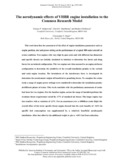JavaScript is disabled for your browser. Some features of this site may not work without it.
| dc.contributor.author | Stankowski, Tomasz | |
| dc.contributor.author | MacManus, David G. | |
| dc.contributor.author | Robinson, Matthew | |
| dc.date.accessioned | 2017-06-19T17:44:59Z | |
| dc.date.available | 2017-06-19T17:44:59Z | |
| dc.date.issued | 2017-05-26 | |
| dc.identifier.citation | Stankowski T, MacManus D, Robinson M, The aerodynamic effects of VHBR engine installation to the Common Research Model, Journal of Aircraft, Vol. 54, Issue 6, 2017, pp. 2270-2284 | en_UK |
| dc.identifier.issn | 0021-8669 | |
| dc.identifier.uri | http://dx.doi.org/10.2514/1.C034150 | |
| dc.identifier.uri | https://dspace.lib.cranfield.ac.uk/handle/1826/12059 | |
| dc.description.abstract | This work describes the assessment of the effect of engine installation parameters such as engine position, size and power setting on the performance of a typical 300 seater aircraft at cruise condition. Two engines with very-high by-pass ratio and with different fan diameters and specific thrusts are initially simulated in isolation to determine the thrust and drag forces for an isolated configuration. The two engines are then assessed in an engine-airframe configuration to determine the sensitivity of the overall installation penalty to the vertical and axial engine location. The breakdown of the interference force is investigated to determine the aerodynamic origins of beneficial or penalising forces. To complete the cruise study a range of engine power settings were considered to determine the installation penalty at different phases of cruise. This work concludes with the preliminary assessment of cruise fuel burn for two engines. For the baseline engine, across the range of installed positions the resultant thrust requirement varied by 1.7% of standard net thrust. The larger engine was less sensitive with a variation of 1.3%. For an assessment over a 10000km cruise flight the overall effect of the lower specific thrust engine showed that the cycle benefits of –5.8% in specific fuel consumption was supplemented by a relatively beneficial aerodynamic installation effect but offset by the additional weight to give a -4.8% fuel burn reduction. | en_UK |
| dc.language.iso | en | en_UK |
| dc.publisher | American Institute of Aeronautics and Astronautics | en_UK |
| dc.rights | Published by American Institute of Aeronautics and Astronautics. This is the Author Accepted Manuscript issued with: Creative Commons Attribution Non-Commercial License (CC:BY:NC 3.0). The final published version (version of record) is available online at DOI:10.2514/1.C034150. Please refer to any applicable publisher terms of use. | |
| dc.title | The aerodynamic effects of VHBR engine installation to the Common Research Model | en_UK |
| dc.type | Article | en_UK |
Files in this item
This item appears in the following Collection(s)
-
Staff publications (SATM) [4395]
